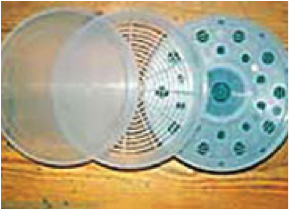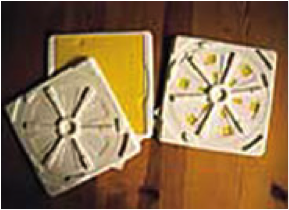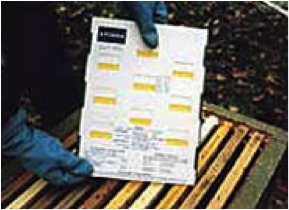Skrevet af: Flemming Vejsnæs
NEW FORMIC ACID VAPORIZERS
MANY NEW VAPORIZERS HAVE BEEN DEVELOPED, AND WORK WELL.
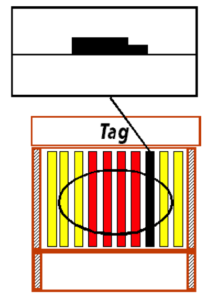
In recent years a great development in the production of formic acid vaporizers has taken place. We have tested several and found them good or acceptable.
THE NASSENHEIDER VAPORIZER
The Nassenheider vaporizer has been on the marked in Denmark for a number of years and is in common use here with good results. The vaporizer comprises two compartments. One for storage and the other for evaporation. In the evaporation compartment one can put a piece of cardboard of two different sizes. The vaporizer can be placed on a lath on an empty frame, so that the apparatus is set half way up the frame. This is so in order for the vaporizer to come into contact with the warmth of the colony.
60 OR 85% SOLUTION
In the vaporisers manual it recommends that a 60% formic acid solution be used. Many of those using the apparatus in Denmark use an 85% solution together with the smaller wick supplied – with good results.
PLACEMENT
It is important that the vaporizer is placed so close to the brood that is is inside the area covered by bees. If necessary the vaporizer can be set up against the most outward brood frame. Should the vaporizer be placed outside the cluster of bees. then there will be an insufficient evaporation. Should the brood have spread to two brood boxes, a second vaporizer should be placed on the upper box, and placed on the opposite side to that underneath.
STARTING TREATMENT
The treatment should start as soon as the last honey has been harvested, and winter feeding begun. The treatment lasts for 7 to 10 days. After the treatment is complete winter feeding can resume.
THE SIZE OF THE WICK
With an early feeding , i.e. in the beginning of August, the smaller piece of cardboard should be inserted. For later treatment, e.g. at the end of September, when the bees have taken all their winter feed, the larger piece of cardboard should be used. Using 85% formic acid solution the smaller piece should be used. This treatment lasts from 14 to 21 days. Check to see that the vaporizer still contains liquid – it may be necessary to refill it.
FILLING
It is recommended that one acquires a squirt bottle to fill the vaporizer with, since it is difficult to do so otherwise without spilling. Check to see that about 10 ml has evaporated every day in the initial treatment.
THE NASSENHEIDER IN A BOX
A further development of the Nassenheider was brought onto the marker last year, making it possible to treat bees in a whole brood box. What’s new here is that one can now put the vaporizer on feet, so that it can be placed on top of the frames. Under the vaporizer an evaporation cloth is laid, which is supplied through a wick from the reservoir. Dependent on the temperature inside the hive, a large or small evaporation area from the cloth is effected. We have scant experience of this type of vaporizer from Denmark.
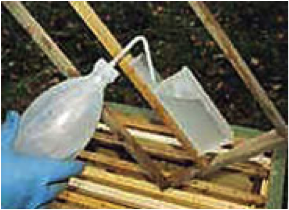
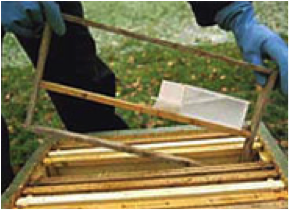
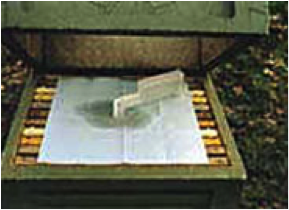
THE APIDEA VAPORIZER
A completely new form for vaporizer on the Danish marked is the apidea vaporizer. The principal is similar to that of the Kråmer board . The vaporizer consists of a tray in which a “dishcloth” is placed , which is able to absorb the formic acid. The tray is encloses by two surfaces, in a hollow system. The opening is created, and regulated, by moving the surfaces away from one another. Evaporation is only created from one side. The vaporizer is best filled using a squirt bottle out in the apiary. The vaporizer should be raised, just like the Kråmer boards, about 2 cm. over the frames. According to the German manual., it is operated with 60, 70 and 85% formic acid solutions. Testing with 85% soln. in Denmark has shown good results, but testing with a 60% soln. has shown less promising results than the Kråmer board method.
THE LIEBERFELDER DISPENSER
The Swiss Bee Research Institute in Lieberfeld, together with The Swiss Beekeeper’s Association have developed a vaporizer similar in principal to the Apidea. The size of the openings are regulated using a rotating disc. The dispenser is supplied with legs which raise it 1.5 cm. above the frames. The dispenser has been tested in Denmark, but is not available for sale here.
THE UNIVERSAL VAPORIZER
Again a dispenser which operates in a similar way to the Kråmer board method. Here a circular plastic container, 3 cm. in height and 16 cm in diameter, is used , containing “oasis” (the absorbent material used in floral decorations) . Above this are two circular discs with a range of openings, which can be regulated according to need. The clever part of this apparatus is that it is supplied with a close fitting lid, which allows the dispenser to be filled at home. The apparatus is tested in Denmark but is not available for sale here.
OTHER VAPORIZERS
There are at the moment two other types of vaporizers that are being researched in Europe. In Southern Germany a so-called plate vaporizer is in use. It works from a drip bottle being suspended on a timber frame and dripping formic acid onto a plate. The method has shown promising results.
In Sweden trials using a so-called “burk” vaporizer, in which a honey jar filled with saw-dust containing formic acid is used. On the top of the jar is a piece of foam. The whole jar is then inverted onto the frames. The method is being tried out in Sweden at he moment. Up until now it has given varied results along with a much too explosive vaporization in the initial treatment.
